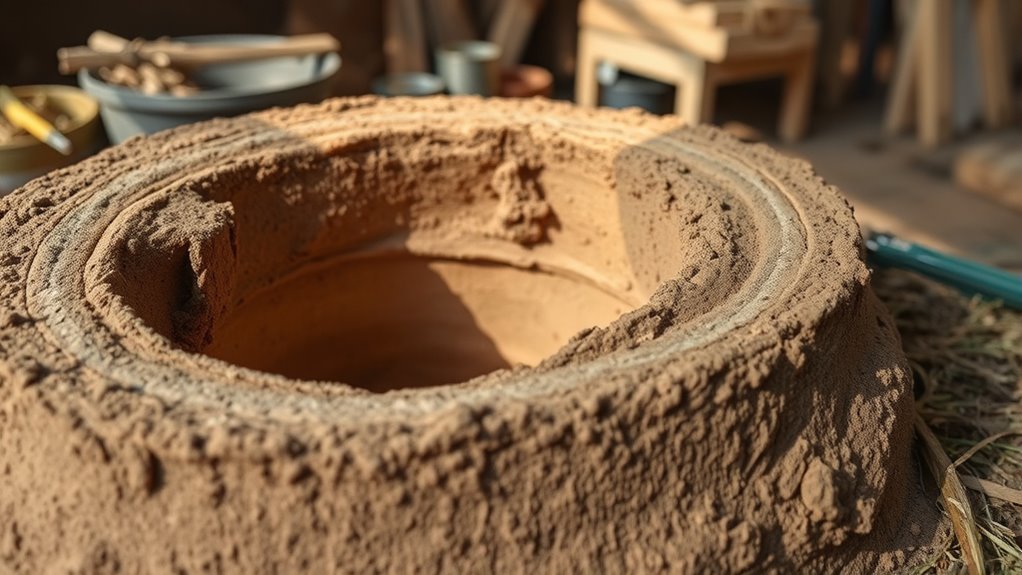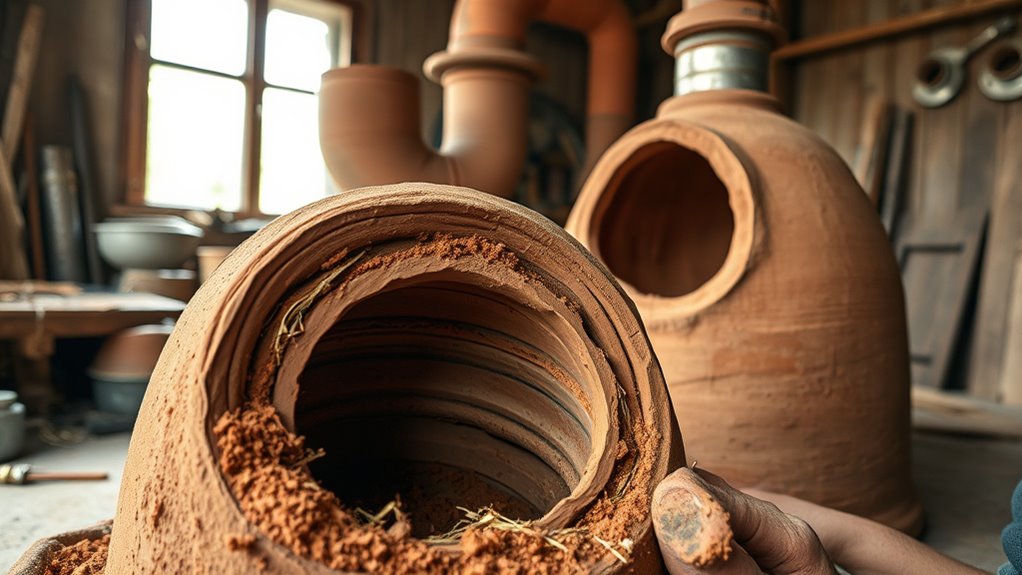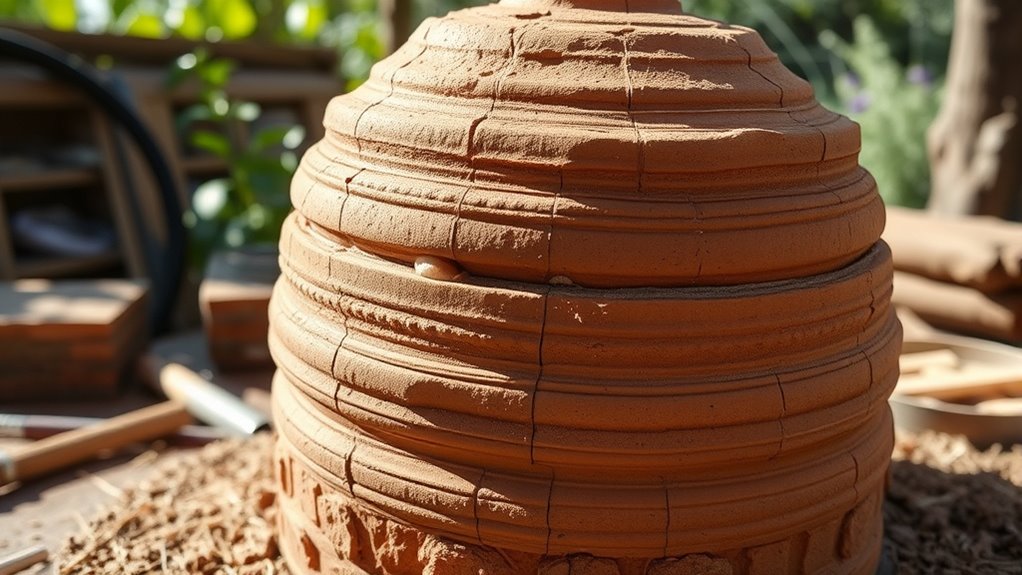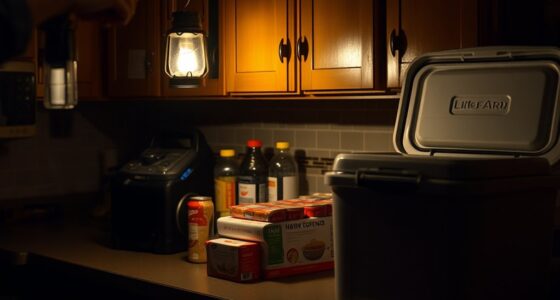To build an earthen rocket stove, start by choosing non-toxic, heat-resistant clay and straw, mixing them with water for a smooth consistency. Construct a sturdy base and combustion chamber using fireproof bricks or stones, insulating with perlite or vermiculite. Build a tall, well-sealed chimney system for proper smoke venting, then finish with safety checks and surface sealing. To guarantee efficient operation and safety, follow proper testing steps—learn more about each step as you continue.
Key Takeaways
- Select and prepare heat-resistant, non-toxic clay and straw, mixing with water for proper consistency while wearing protective gear.
- Construct a sturdy, insulated combustion chamber using dense, fireproof bricks or stones, ensuring proper layering and stability.
- Build a tall, sealed chimney with insulated flue pipes to optimize draft and smoke evacuation.
- Finish with safety inspections, sealing joints, smoothing surfaces, and applying protective, fire-resistant sealants.
- Test the stove with small dry materials, monitor temperature and airflow, and perform routine maintenance for optimal performance.
Gathering and Preparing Your Materials

Before building your earthen rocket stove, you need to gather and prepare the right materials. Focus on material selection to guarantee durability and safety. Use heat-resistant, non-toxic clay and straw for the earthen mixture, avoiding materials that release harmful fumes or break down under high temperatures. Safety considerations are essential—wear gloves and a mask during mixing to prevent inhaling dust or irritants. Choose sturdy, fireproof bricks or stones for the combustion chamber to withstand heat stress. Gather clean water to mix with the clay and straw, ensuring the right consistency. Double-check that all materials are free from contaminants or debris. Proper preparation not only enhances safety but also boosts the stove’s efficiency and longevity. Additionally, selecting sustainably sourced building materials can help minimize environmental impact during construction. Incorporating eco-friendly materials can further improve the sustainability of your project. Being mindful of the environmental impact of your choices ensures a more sustainable and responsible building process. Moreover, understanding the properties of clay and straw will help in achieving a durable and well-insulated stove.
Constructing the Base and Combustion Chamber

To construct the base and combustion chamber, start by laying a sturdy foundation using fireproof bricks or stones arranged in a stable rectangle or square shape. This provides a solid platform for your stove and enhances fuel efficiency by maintaining consistent heat. Next, build the combustion chamber with insulating techniques in mind—use dense, heat-resistant materials to reduce heat loss. Proper insulation helps improve combustion efficiency and directs heat where it’s needed most. Use the table below to plan your materials:
| Material | Purpose | Insulation Techniques |
|---|---|---|
| Fireproof bricks | Base and chamber support | Layered for stability |
| Perlite or vermiculite | Insulation | Mix with clay for lining |
| Refractory cement | Seal joints | Apply around chamber edges |
This setup boosts your stove’s overall performance. Additionally, understanding local zoning laws can help ensure your project complies with regional regulations and permits.
Building the Chimney and Flue System

Once you have built the combustion chamber, it’s vital to construct a proper chimney and flue system to guarantee efficient smoke venting and safe operation. Start by selecting a durable flue pipe design that minimizes heat loss and maximizes airflow. Confirm the pipe is properly insulated with chimney insulation to prevent heat transfer and condensation, which can cause blockages or corrosion. The chimney should be tall enough to create a strong draft, pulling smoke smoothly out of your stove. Secure the flue pipe firmly and seal joints tightly to prevent leaks. Proper insulation and thoughtful pipe design help maintain consistent airflow, improving combustion efficiency and reducing smoke emissions. Additionally, choosing an appropriate flue pipe that is compatible with your stove’s specifications can significantly enhance overall performance. Using insulated chimney pipes helps maintain optimal temperatures and prevents heat loss, further increasing efficiency. Ensuring the correct chimney height is essential for creating a proper draft and efficient operation. Considering the performance of the chimney system can also contribute to better smoke evacuation and stove efficiency. This setup ensures your earthen rocket stove operates safely and efficiently.
Finishing Touches and Safety Checks

After completing the main construction, it’s vital to perform thorough safety checks and add finishing touches to guarantee your earthen rocket stove operates safely and efficiently. Begin with safety inspections, checking for cracks, unstable joints, or weak spots in the structure. Ensure the chimney and flue system are secure and properly sealed. Once safety is confirmed, focus on decorative finishes to protect the surface and improve aesthetics. You can add clay slip or natural sealants to enhance durability and give your stove a polished look. Make sure all surfaces are smooth and free of sharp edges. These finishing touches not only improve appearance but also help prevent cracks or damage over time. Incorporating visual inspection into your practice can help you identify potential issues early, ensuring your stove remains safe and functional. Regular maintenance and structural integrity checks are essential for long-term safety. Additionally, using appropriate protective coatings can extend the lifespan of your stove’s surface. Proper application of fire-resistant sealants can further enhance safety by resisting high temperatures and reducing the risk of deterioration. Taking these steps ensures your stove is both safe to use and visually appealing.
Testing and Using Your Rocket Stove

Before you start cooking with your rocket stove, it’s crucial to test it thoroughly to guarantee safe and efficient operation. Begin by practicing ignition techniques, using small, dry materials to start a quick, hot fire. Observe how well the fire draws air through the burn chamber and ensure there are no leaks or blockages. Once lit, monitor fuel efficiency by noting how much wood you need to maintain a steady flame. Adjust the airflow if the fire struggles to ignite or burns unevenly. Use a thermometer to check the temperature consistency, ensuring ideal heat transfer. Regular testing helps you refine your technique, maximize fuel efficiency, and prevent safety issues. Proper testing and familiarization make your rocket stove safer and more effective for everyday use. Incorporating proper maintenance routines will also extend the lifespan of your stove and improve its overall performance. Additionally, understanding automation in business can inspire ways to streamline stove maintenance processes for better longevity. Conducting routine inspections can help identify potential problems early and keep your stove functioning at its best. Moreover, understanding potential pitfalls in adopting new technologies can help you avoid common mistakes and ensure your stove remains reliable over time.
Frequently Asked Questions
Can I Customize the Size of My Earthen Rocket Stove?
You can definitely customize the size of your earthen rocket stove. This allows for greater design flexibility, so you can tailor it to fit your specific needs and available space. When adjusting the size, consider how it will impact airflow and combustion efficiency. Keep in mind that larger stoves may require more materials and time, but they can also provide more heat output, making your stove more effective and personalized.
What Types of Soil Are Best for Construction?
Think of soil like a sturdy foundation—choosing the right mix matters. For construction, you want soil with good stabilization qualities, often achieved with moderate clay content, which helps it hold shape without cracking. I once built a small bench using soil with proper stabilization; it stayed firm through rain and sun. Use soils with balanced clay for durability, avoiding overly sandy or silty mixes that lack cohesion.
How Do I Ensure Proper Insulation for Efficiency?
To guarantee proper insulation for heat retention, you should select effective insulation materials like perlite, vermiculite, or straw, which trap heat inside. Apply these materials around the stove’s combustion chamber and along the exterior to minimize heat loss. You can also add a protective layer of clay or mud to improve durability. Proper insulation keeps your stove efficient, reducing fuel use and increasing safety during operation.
Are There Any Environmental Considerations During Building?
When considering environmental factors, you should focus on eco-friendly materials and site selection. Choose sustainable, non-toxic materials like clay, straw, or recycled components to minimize impact. Carefully select a site that avoids sensitive ecosystems, reducing habitat disturbance. This thoughtful approach guarantees your project remains environmentally responsible, promoting sustainability while building. By prioritizing eco-friendly choices and proper site planning, you help protect the environment throughout your construction process.
How Do I Troubleshoot Common Performance Issues?
When troubleshooting performance issues, start by checking your fuel efficiency. Make sure you’re using dry, well-seasoned fuel for better combustion. Next, optimize airflow by inspecting the air intake and chimney; verify there’s no blockage and that air can flow freely. Adjust the damper if needed to improve combustion. Consistently cleaning the stove and removing ash buildup can also enhance airflow, helping your stove burn more efficiently and improve overall performance.
Conclusion
Now that your earthen rocket stove is built, you hold a simple yet powerful tool for warmth and cooking. It’s a blend of raw materials and ingenuity, transforming basic elements into a reliable source of heat. While its rustic appearance contrasts with modern appliances, its efficiency and eco-friendliness prove that sometimes, the most basic methods are the most effective. Embrace this balance of tradition and innovation, forging a sustainable path forward.









